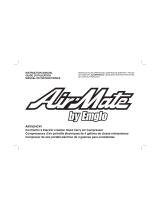
3. Open the drain valve (turn lever counter-clockwise) fuIly to
permit air to escape and prevent air pressure build up in the air
tank during the break-in period.
4. Move the On/Off switch to the ON position. The compressor will
start.
5. Run the compressor for 15 minutes.
6. After 15 minutes, close the drain valve by turning lever
clockwise. The tank will fill to cut-out pressure and the motor
will stop.
7. Compressed air will be available until it is used or bled off
OPERATING PROCEDURES
Start-up (Fig. I)
1. Follow Pre-Start Checklist under Preparation for Use.
2. Move the On/Off switch to the ON position and allow tank
pressure to build. Motor will stop when tank pressure reaches
cut-out pressure
&CAUTION: Risk of unsafe operation. Compressed air from the
unit may contain water condensation and eft mist. Do not spray until-
tered air at an item that could be damaged by moisture. Some air
operated tools or devices may require filtered air. Read the instruc-
tions for the air tool or device.
3. Adjust regulator (D) to desired setting. See Regulator under
Features.
Shut-down (Fig. I)
1. Move On/Off switch (A) to the OFF position. NOTE: If finished
using compressor, follow Steps 2 - 6.
NOTE: When the unit has been turned off, it is normal to hear a
short hiss of air being released.
2. Turn regulator knob (D) counterclockwise until fully closed. Ensure
regulated pressure gauge reads 0 PSI (0 kPa).
3. Remove hose and accessory.
_, WARNING: Risk of unsafe operation. Firmly grasp air hose in hand
when installing or disconnecting to prevent hose whip.
4. Drain the air tank, see Draining Air Tank under Maintenance.
Ensure air tank pressure gauge reads OPSi (0 kPa).
_t,WARNING: Risk of bursting. Drain air tank daily. Water will
condense in air tank. If net drained, water will corrode and weaken
the air tank causing a risk of air tank rupture.
5. Allow the compressor to coot down.
6. Wipe air compressor clean and store in a safe, non-freezing area.
MAINTENANCE
The following procedures must be followed 'when maintenance or
service is performed on the air compressor.
1. Ensure On/Off switch is in the OFF position.
2. Remove air compressor plug from outlet.
3. Drain air tank.
4. Allow air compressor to coot down before starting service.
NOTE: All compressed air systems contain maintenance parts (e.g.,
oil, filters, separators) that are periodically replaced. These used parts
may contain substances that are regulated and must be disposed of in
accordance with local, state, and federat taws and regulations.
NOTE: Take note of the positions and locations of parts during
disassembly to make reassembly easier.
NOTE: Any service operations not included in this section shoutd
be performed by a DEWALT factory service center or a DEWALT
authorized service center
12



















